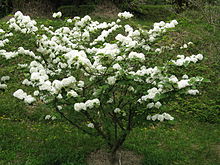en
names in breadcrumbs


Viburnum is a genus of about 150–175 species of flowering plants in the moschatel family Adoxaceae. Its current classification is based on molecular phylogeny.[2] It was previously included in the honeysuckle family Caprifoliaceae.[1]
The member species are evergreen or deciduous shrubs or (in a few cases) small trees native throughout the temperate Northern Hemisphere, with a few species extending into tropical montane regions in South America and southeast Asia. In Africa, the genus is confined to the Atlas Mountains.
The generic name Viburnum originated in Latin, where it referred to V. lantana.[3][4]
The leaves are opposite, simple, and entire, toothed or lobed; cool temperate species are deciduous, while most of the warm temperate species are evergreen. Some species are densely hairy on the shoots and leaves, with star-shaped hairs.
The flowers are produced in corymbs 5–15 cm across, each flower white to cream or pink, small, 3–5 mm across, with five petals, strongly fragrant in some species. The gynoecium has three connate carpels with the nectary on top of the gynoecium. Some species also have a fringe of large, showy sterile flowers around the perimeter of the corymb to act as a pollinator target.
The fruit is a spherical, oval, or somewhat flattened drupe, red to purple, blue, or black, and containing a single seed; some are edible for humans, but many others are mildly poisonous. The leaves are eaten by the larvae of many Lepidoptera species.
Around 165 species are described. A 2014 phylogenetic study[5] proposed the following phylogenetic scheme and sections:
Lentago (7 species)
PaleovaltinusPunctata (2)
Euviburnum (15)
Pseudotinus (4)
Pluriviburnum Perplexitinus Amplicrenotinus CrenotinusSolenotinus (22)
LutescentiaTomentosa (2)
Urceolata (2)
NectarotinusTinus (8)
Imbricotinus Laminotinus CorrisuccotinusSuccotinus (34)
Coriaceae (3)
Sambucina (10)
Opulus (5)
PorphyrotinusMollotinus (5)
OreinodentinusDentata (3)
Oreinotinus (30)
Lentago – Eastern North America except for V. elatum in Mexico[6]
Punctata
Euviburnum
Pseudotinus – Asia, except V. lantanoides in Eastern North America[6]
Solenotinus – Asia, extending west to India and south to Indonesia[6]
Lutescentia (excluding Tomentosa)
Tomentosa – China, Japan[6]
Amplicrenotinus (excluding Crenotinus)
Urceolata
Tinus – Asia, except V. tinus in Europe[6]
Corisuccotinus (excluding Succotinus and Coriaceae)
Succotinus
Coriaceae
Sambucina
Opulus – Circumboreal[6]
Mollotinus
Dentata – Mexico, Caribbean, and Central and South America[6]
Oreinotinus – Mexico, Caribbean, and Central and South America[6]
Undetermined

Many species of viburnum have become popular as garden or landscape plants because of their showy flowers and berries, fragrance, and good autumn colour of some forms. Some popular species, hybrids, and cultivars include:[9]
The cultivars 'Pragense'[10] and 'Eskimo',[11] of mixed or uncertain parentage, have won the Royal Horticultural Society's Award of Garden Merit.
In prehistory, the long, straight shoots of some viburnums were used for arrow-shafts, as those found with Ötzi the Iceman.
The fruit of some species (e.g. V. lentago[12]) are edible and can be eaten either raw or for making jam, while other species (e.g. V. opulus[13]) are mildly toxic and can cause vomiting if eaten in quantity.
The bark of some species is used in herbal medicine, as an antispasmodic and to treat asthma.[13]
In Ukraine Viburnum opulus is an important element of their traditional folk cultures. In Ukraine, Viburnum opulus (kalyna) is seen as a national symbol, an emblem for both the Koliada festivities and the concept of young girl's love and tenderness. It is the key element of the Ukrainian traditional wreath. Number of folk songs are dedicated to Kalyna as well as very popular song '"Oi u Luzi Chervona Kalina"
Viburnum is a genus of about 150–175 species of flowering plants in the moschatel family Adoxaceae. Its current classification is based on molecular phylogeny. It was previously included in the honeysuckle family Caprifoliaceae.
The member species are evergreen or deciduous shrubs or (in a few cases) small trees native throughout the temperate Northern Hemisphere, with a few species extending into tropical montane regions in South America and southeast Asia. In Africa, the genus is confined to the Atlas Mountains.